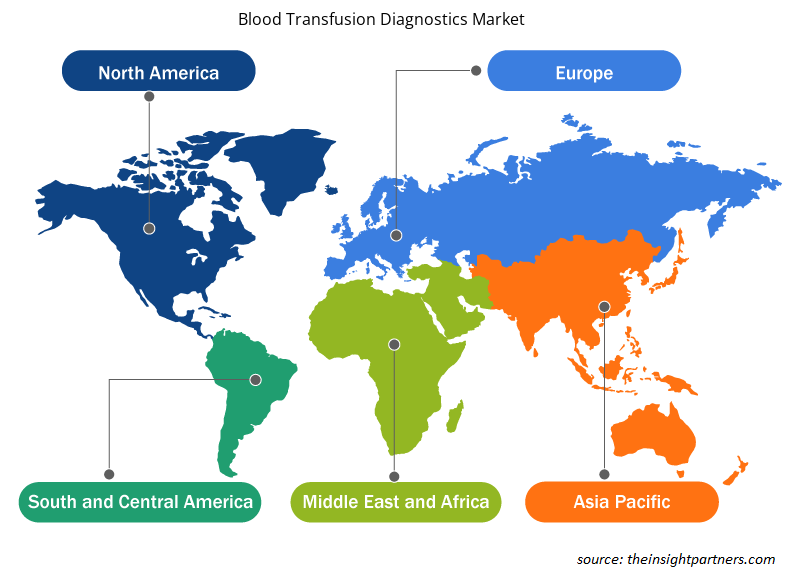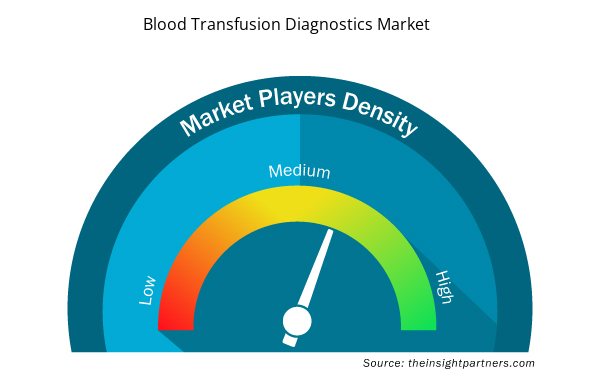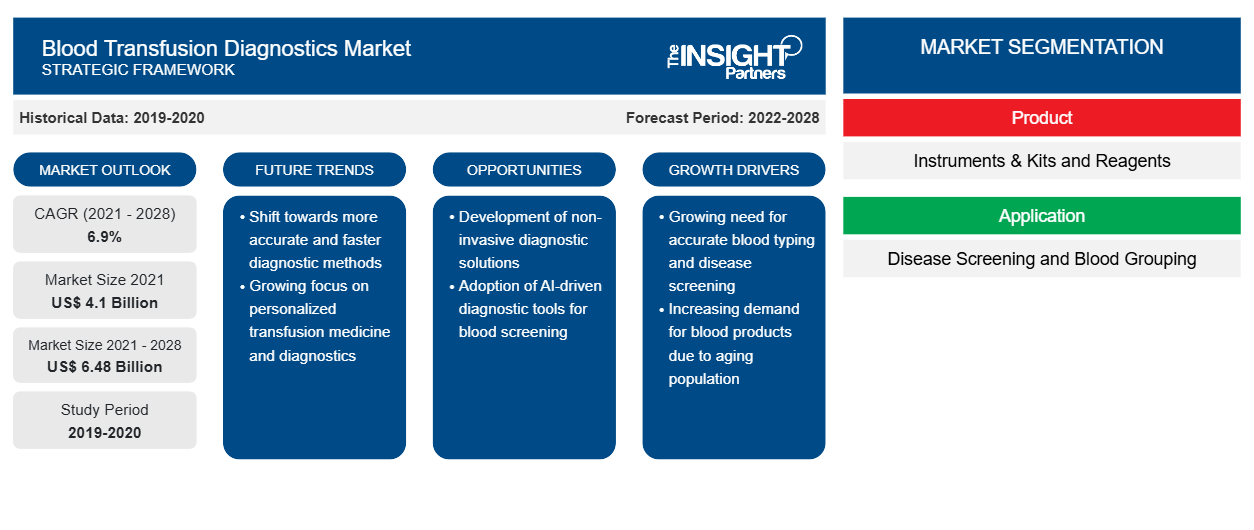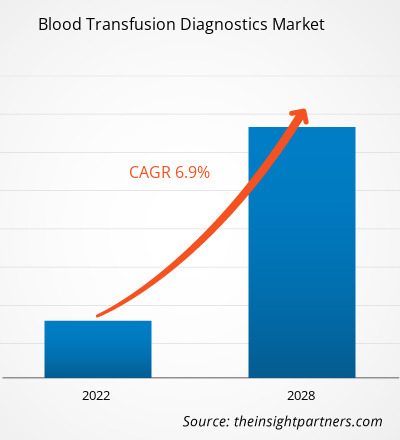[Rapport de recherche] Le marché du diagnostic de transfusion sanguine devrait passer de 4 096,93 millions USD en 2021 à 6 483,75 millions USD en 2028. Il devrait croître à un TCAC de 6,9 % de 2022 à 2028.
Les diagnostics de transfusion sanguine sont des tests effectués sur le sang avant qu'il ne soit transfusé aux patients. Une transfusion sanguine est une procédure courante au cours de laquelle le sang donné ou ses composants sont transfusés dans le corps du patient par voie intraveineuse. Chaque unité de sang doit être soumise à un typage sanguin, qui fait référence à l'identification du groupe sanguin et au dépistage sanguin, y compris aux tests de détection de maladies pour éviter les effets secondaires ou la transmission d'infections.
Le rapport offre des informations et une analyse approfondie du marché mondial du diagnostic de transfusion sanguine , en mettant l'accent sur divers paramètres, notamment les tendances du marché, les avancées technologiques, la dynamique du marché et l'analyse du paysage concurrentiel des principaux acteurs du marché mondial. Il comprend également l'impact de la pandémie de COVID-19 sur le marché dans toutes les régions. La pandémie de COVID-19 a eu un impact négatif sur la croissance du marché mondial du diagnostic de transfusion sanguine. Elle a montré une énorme baisse des revenus en raison des restrictions strictes imposées par le gouvernement, entraînant une diminution du nombre d'interventions chirurgicales effectuées. Ces services sont principalement utilisés dans les interventions chirurgicales à forte perte de sang, telles que les chirurgies orthopédiques et cardiaques. En raison de la diminution du nombre d'interventions chirurgicales effectuées, la demande de transfusion sanguine a diminué. Par exemple : selon les données publiées par l'American Medical Association, on estime qu'il y a eu une réduction de 48 % du nombre total d'interventions chirurgicales pratiquées aux États-Unis en raison de la pandémie de COVID-19. Cependant, après la normalisation des restrictions liées à la pandémie, le volume des interventions chirurgicales est revenu à des niveaux normaux.
Personnalisez ce rapport en fonction de vos besoins
Vous bénéficierez d'une personnalisation gratuite de n'importe quel rapport, y compris de certaines parties de ce rapport, d'une analyse au niveau des pays, d'un pack de données Excel, ainsi que de superbes offres et réductions pour les start-ups et les universités.
- Obtenez les principales tendances clés du marché de ce rapport.Cet échantillon GRATUIT comprendra une analyse de données, allant des tendances du marché aux estimations et prévisions.
Informations basées sur la géographie
Sur le plan géographique, le marché mondial du diagnostic de transfusion sanguine est segmenté en Amérique du Nord (États-Unis, Canada et Mexique), Europe (France, Allemagne, Royaume-Uni, Espagne, Italie et reste de l'Europe), Asie-Pacifique (Chine, Inde, Japon, Australie, Corée du Sud et reste de l'APAC), Moyen-Orient et Afrique (Arabie saoudite, Émirats arabes unis, Afrique du Sud et reste de la région MEA) et Amérique du Sud et centrale (Brésil, Argentine et reste de l'Amérique du Sud et centrale).APAC), the Middle East & Africa (Saudi Arabia, the UAE, South Africa, and the Rest of the MEA), and South & Central America (Brazil, Argentina, and the Rest of South & Central America).
Informations sur le marché
Nécessité de transfusion sanguine en raison de l'augmentation des transplantations d'organes
La transplantation d'organe est une intervention chirurgicale pratiquée en cas de défaillance d'organe. En général, les transplantations d'organes concernent le cœur, le foie, les reins et divers autres organes en raison de l'augmentation des cas de maladies chroniques, telles que l'insuffisance rénale chronique (IRC), la polykystose rénale, la fibrose kystique et les cardiopathies congénitales, qui nécessitent des transplantations. Ces procédures prennent généralement des heures, entraînent une perte de sang importante et nécessitent une transfusion sanguine. Par exemple, selon le United Network for Organ Sharing (UNOS), les transplantations d'organes réalisées aux États-Unis n'ont cessé d'augmenter, avec plus de 41 000 transplantations réalisées en 2021. De même, selon les données du World Transplant Registry, l'Espagne représentait 20 % de tous les dons d'organes en Europe en 2019 et 6 % dans le monde. Le taux de donneurs d'organes en Australie s'est récemment amélioré, passant à 21,8 donneurs par million d'habitants en 2019.
Français De même, le Canada compte 22,2 donneurs par million d'habitants et s'améliore régulièrement, en partie grâce au chiffre des « médecins spécialistes des dons », c'est-à-dire des médecins de soins intensifs responsables des dons d'organes. Selon le Registre mondial des transplantations, la Chine comptait 5 818 donneurs en 2019, soit 4,1 par million d'habitants, et l'Inde 715 donneurs, soit 0,5 par million d'habitants en 2019. En revanche, la Russie avait un taux légèrement supérieur de 5,1 donneurs par million d'habitants. Le partenariat public-privé, en collaboration avec les coordinateurs de transplantation, a contribué de manière significative à l'amélioration des transplantations d'organes nécessitant une transfusion sanguine constante. Les pays en développement comme les pays développés ont connu une augmentation des opérations de transplantation d'organes. Par exemple, les pays en développement, comme l'Inde et Singapour, émergent comme destinations de tourisme médical en Asie-Pacifique. Les pays progressent en termes de fourniture de traitements médicaux meilleurs et avancés. Le besoin croissant de transplantations d'organes est l'un des principaux facteurs qui stimulent la demande de diagnostics de transfusion sanguine dans le monde entier.
Informations basées sur les produits
En fonction du produit, le marché mondial du diagnostic de transfusion sanguine est divisé en instruments et kits et réactifs. En 2021, le segment des instruments et kits représentait une part de marché plus importante. Le même segment devrait enregistrer un TCAC plus élevé sur le marché de 2022 à 2028.
Informations basées sur les applications
En fonction des applications, le marché mondial du diagnostic de transfusion sanguine est divisé en deux segments : le dépistage des maladies et le groupage sanguin. Le segment du dépistage des maladies détenait une part de marché plus importante en 2021 et devrait enregistrer un TCAC plus élevé au cours de la période de prévision.
Aperçu régional du marché du diagnostic de transfusion sanguine
Les tendances régionales et les facteurs influençant le marché du diagnostic de transfusion sanguine tout au long de la période de prévision ont été expliqués en détail par les analystes d’Insight Partners. Cette section traite également des segments et de la géographie du marché du diagnostic de transfusion sanguine en Amérique du Nord, en Europe, en Asie-Pacifique, au Moyen-Orient et en Afrique, ainsi qu’en Amérique du Sud et en Amérique centrale.

- Obtenez les données régionales spécifiques au marché du diagnostic de transfusion sanguine
Portée du rapport sur le marché des diagnostics de transfusion sanguine
| Attribut de rapport | Détails |
|---|---|
| Taille du marché en 2021 | 4,1 milliards de dollars américains |
| Taille du marché d'ici 2028 | 6,48 milliards de dollars américains |
| Taux de croissance annuel moyen mondial (2021-2028) | 6,9% |
| Données historiques | 2019-2020 |
| Période de prévision | 2022-2028 |
| Segments couverts | Par produit
|
| Régions et pays couverts | Amérique du Nord
|
| Leaders du marché et profils d'entreprises clés |
|
Densité des acteurs du marché du diagnostic de transfusion sanguine : comprendre son impact sur la dynamique commerciale
Le marché du diagnostic de transfusion sanguine connaît une croissance rapide, tirée par la demande croissante des utilisateurs finaux en raison de facteurs tels que l'évolution des préférences des consommateurs, les avancées technologiques et une plus grande sensibilisation aux avantages du produit. À mesure que la demande augmente, les entreprises élargissent leurs offres, innovent pour répondre aux besoins des consommateurs et capitalisent sur les tendances émergentes, ce qui alimente davantage la croissance du marché.
La densité des acteurs du marché fait référence à la répartition des entreprises ou des sociétés opérant sur un marché ou un secteur particulier. Elle indique le nombre de concurrents (acteurs du marché) présents sur un marché donné par rapport à sa taille ou à sa valeur marchande totale.
Les principales entreprises opérant sur le marché du diagnostic de transfusion sanguine sont :
- Grifols, SA
- F. Hoffmann-La Roche SARL
- Immucor, Inc.
- Laboratoires Bio-Rad Inc.
- Abbott
Avis de non-responsabilité : les sociétés répertoriées ci-dessus ne sont pas classées dans un ordre particulier.

- Obtenez un aperçu des principaux acteurs du marché du diagnostic de transfusion sanguine
Informations basées sur l'utilisateur final
En fonction de l'utilisateur final, le marché mondial du diagnostic de transfusion sanguine est segmenté en banques de sang, hôpitaux, laboratoires de diagnostic et sociétés de fractionnement du plasma . Le segment des banques de sang détenait la plus grande part de marché en 2021. Le même segment devrait enregistrer le TCAC le plus élevé du marché de 2022 à 2028.
Les acteurs du marché mondial du diagnostic de transfusion sanguine adoptent des stratégies organiques, notamment le lancement et l'expansion de produits, pour étendre leur présence et leur portefeuille de produits dans le monde entier et répondre à la demande croissante. Les principaux acteurs du marché sont Grifols, SA ; F. Hoffmann-La Roche Ltd ; Immucor, Inc. ; Bio-Rad Laboratories, Inc. ; Abbott ; Thermo Fisher Scientific Inc. ; Ortho Clinical Diagnostics ; DiaSorin SpA ; Quotient Limited ; et BAG Diagnostics GmbH.
- Analyse historique (2 ans), année de base, prévision (7 ans) avec TCAC
- Analyse PEST et SWO
- Taille du marché Valeur / Volume - Mondial, Régional, Pays
- Industrie et paysage concurrentiel
- Ensemble de données Excel


- Nuclear Decommissioning Services Market
- Mesotherapy Market
- Quantitative Structure-Activity Relationship (QSAR) Market
- Sleep Apnea Diagnostics Market
- Sandwich Panel Market
- Truck Refrigeration Market
- Queue Management System Market
- Cell Line Development Market
- Tortilla Market
- Europe Industrial Chillers Market

Report Coverage
Revenue forecast, Company Analysis, Industry landscape, Growth factors, and Trends

Segment Covered
This text is related
to segments covered.

Regional Scope
North America, Europe, Asia Pacific, Middle East & Africa, South & Central America

Country Scope
This text is related
to country scope.
Questions fréquemment posées
Global blood transfusion diagnostics market is segmented by region into North America, Europe, Asia Pacific, Middle East & Africa, and South & Central America. In North America, the U.S. is the largest market for blood transfusion diagnostics market. The growth of the market in North America is expected due to the factors such as increasing surgical procedures for chronic health conditions, rising collaborative agreements between key players, and growing progress in the health system for blood transfusion diagnostics. However, the improvement in blood transfusion management, increasing prevalence of sepsis and thalassemia, and the introduction of advanced molecular platforms are the key factor responsible for the Asia-Pacific regional growth for blood transfusion diagnostics accounting fastest growth of the region during the coming years.
Grifols, S.A.; F. Hoffmann-La Roche Ltd; DiaSorin S.p.A.; BAG Diagnostics GmbH; Abbott; Bio-Rad Laboratories, Inc.; Immucor, Inc.; Thermo Fisher Scientific Inc.; Ortho Clinical Diagnostics; and Quotient Limited are among the leading companies operating in the blood transfusion diagnostics market.
The blood banks segment dominated the global blood transfusion diagnostics market and accounted for the largest market share of 40.23% in 2021.
Based on application, disease screening segment took the forefront lead in the worldwide market by accounting largest share in 2021 and is expected to continue to do so till the forecast period.
Based on products, instruments and kits segment took the forefront lead in the worldwide market by accounting largest share in 2021 and is expected to continue to do so till the forecast period.
Blood transfusion diagnostics refers to tests performed on blood and blood components before they are transfused to patients. A blood transfusion is a common procedure in which donated blood or blood components are transfused into the patient's body through an intravenous line (IV). Each unit of blood must undergo blood typing, which refers to the identification of blood type and blood screening, including disease detection tests to avoid side effects or transmission of infection. Blood screening before transfusion is performed through instruments, kits, and reagents to identify various diseases, such as HIV, hepatitis B, hepatitis C, Zika, and different viruses and infections.
Rapid increase in chronic diseases and increasing need for blood transfusion due to rise in organ transplants surgeries are the most significant factors responsible for the overall market growth.
Trends and growth analysis reports related to Life Sciences : READ MORE..
The List of Companies - Blood Transfusion Diagnostics Market
- Grifols, S.A.
- F. Hoffmann-La Roche Ltd
- Immucor, Inc.
- Bio-Rad Laboratories Inc.
- Abbott
- Thermo Fisher Scientific Inc.
- Ortho Clinical Diagnostics
- DiaSorin S.p.A.
- Quotient Limited
- BAG Diagnostics GmbH
The Insight Partners performs research in 4 major stages: Data Collection & Secondary Research, Primary Research, Data Analysis and Data Triangulation & Final Review.
- Data Collection and Secondary Research:
As a market research and consulting firm operating from a decade, we have published and advised several client across the globe. First step for any study will start with an assessment of currently available data and insights from existing reports. Further, historical and current market information is collected from Investor Presentations, Annual Reports, SEC Filings, etc., and other information related to company’s performance and market positioning are gathered from Paid Databases (Factiva, Hoovers, and Reuters) and various other publications available in public domain.
Several associations trade associates, technical forums, institutes, societies and organization are accessed to gain technical as well as market related insights through their publications such as research papers, blogs and press releases related to the studies are referred to get cues about the market. Further, white papers, journals, magazines, and other news articles published in last 3 years are scrutinized and analyzed to understand the current market trends.
- Primary Research:
The primarily interview analysis comprise of data obtained from industry participants interview and answers to survey questions gathered by in-house primary team.
For primary research, interviews are conducted with industry experts/CEOs/Marketing Managers/VPs/Subject Matter Experts from both demand and supply side to get a 360-degree view of the market. The primary team conducts several interviews based on the complexity of the markets to understand the various market trends and dynamics which makes research more credible and precise.
A typical research interview fulfils the following functions:
- Provides first-hand information on the market size, market trends, growth trends, competitive landscape, and outlook
- Validates and strengthens in-house secondary research findings
- Develops the analysis team’s expertise and market understanding
Primary research involves email interactions and telephone interviews for each market, category, segment, and sub-segment across geographies. The participants who typically take part in such a process include, but are not limited to:
- Industry participants: VPs, business development managers, market intelligence managers and national sales managers
- Outside experts: Valuation experts, research analysts and key opinion leaders specializing in the electronics and semiconductor industry.
Below is the breakup of our primary respondents by company, designation, and region:

Once we receive the confirmation from primary research sources or primary respondents, we finalize the base year market estimation and forecast the data as per the macroeconomic and microeconomic factors assessed during data collection.
- Data Analysis:
Once data is validated through both secondary as well as primary respondents, we finalize the market estimations by hypothesis formulation and factor analysis at regional and country level.
- Macro-Economic Factor Analysis:
We analyse macroeconomic indicators such the gross domestic product (GDP), increase in the demand for goods and services across industries, technological advancement, regional economic growth, governmental policies, the influence of COVID-19, PEST analysis, and other aspects. This analysis aids in setting benchmarks for various nations/regions and approximating market splits. Additionally, the general trend of the aforementioned components aid in determining the market's development possibilities.
- Country Level Data:
Various factors that are especially aligned to the country are taken into account to determine the market size for a certain area and country, including the presence of vendors, such as headquarters and offices, the country's GDP, demand patterns, and industry growth. To comprehend the market dynamics for the nation, a number of growth variables, inhibitors, application areas, and current market trends are researched. The aforementioned elements aid in determining the country's overall market's growth potential.
- Company Profile:
The “Table of Contents” is formulated by listing and analyzing more than 25 - 30 companies operating in the market ecosystem across geographies. However, we profile only 10 companies as a standard practice in our syndicate reports. These 10 companies comprise leading, emerging, and regional players. Nonetheless, our analysis is not restricted to the 10 listed companies, we also analyze other companies present in the market to develop a holistic view and understand the prevailing trends. The “Company Profiles” section in the report covers key facts, business description, products & services, financial information, SWOT analysis, and key developments. The financial information presented is extracted from the annual reports and official documents of the publicly listed companies. Upon collecting the information for the sections of respective companies, we verify them via various primary sources and then compile the data in respective company profiles. The company level information helps us in deriving the base number as well as in forecasting the market size.
- Developing Base Number:
Aggregation of sales statistics (2020-2022) and macro-economic factor, and other secondary and primary research insights are utilized to arrive at base number and related market shares for 2022. The data gaps are identified in this step and relevant market data is analyzed, collected from paid primary interviews or databases. On finalizing the base year market size, forecasts are developed on the basis of macro-economic, industry and market growth factors and company level analysis.
- Data Triangulation and Final Review:
The market findings and base year market size calculations are validated from supply as well as demand side. Demand side validations are based on macro-economic factor analysis and benchmarks for respective regions and countries. In case of supply side validations, revenues of major companies are estimated (in case not available) based on industry benchmark, approximate number of employees, product portfolio, and primary interviews revenues are gathered. Further revenue from target product/service segment is assessed to avoid overshooting of market statistics. In case of heavy deviations between supply and demand side values, all thes steps are repeated to achieve synchronization.
We follow an iterative model, wherein we share our research findings with Subject Matter Experts (SME’s) and Key Opinion Leaders (KOLs) until consensus view of the market is not formulated – this model negates any drastic deviation in the opinions of experts. Only validated and universally acceptable research findings are quoted in our reports.
We have important check points that we use to validate our research findings – which we call – data triangulation, where we validate the information, we generate from secondary sources with primary interviews and then we re-validate with our internal data bases and Subject matter experts. This comprehensive model enables us to deliver high quality, reliable data in shortest possible time.


 Obtenez un échantillon gratuit pour ce rapport
Obtenez un échantillon gratuit pour ce rapport